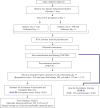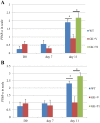Gene expression dynamics during diabetic periodontitis
- PMID: 23103632
- PMCID: PMC3497909
- DOI: 10.1177/0022034512465292
Gene expression dynamics during diabetic periodontitis
Abstract
Diabetes impairs the resolution of periodontal inflammation. We explored pathways altered by inflammation in the diabetic periodontium by using ligatures to induce periodontitis in type-2 diabetic Goto-Kakizaki rats. Ligatures were removed after 7 days, and rats were then treated with TNF inhibitor (pegsunercept) or vehicle alone and euthanized 4 days later. RNA was extracted from periodontal tissue, examined by mRNA profiling, and further analyzed by functional criteria. We found that 1,754 genes were significantly up-regulated and 1,243 were down-regulated by pegsunercept (p < 0.05). Functional analysis revealed up-regulation of neuron-associated and retina-associated gene clusters as well as those related to cell activity and signaling. Others were down-regulated by TNF inhibition and included genes associated with host defense, apoptosis, cell signaling and activity, and coagulation/hemostasis/complement. For selected genes, findings with microarray and rt-PCR agreed. PPAR-α was investigated further by immunohistochemistry due to its anti-inflammatory function and was found to be up-regulated in the gingiva during the resolution of periodontal inflammation and suppressed by diabetes. The results indicate that diabetes-enhanced inflammation both up- and down-regulates genes involved in cellular activity and cell signaling, while it predominantly up-regulates genes involved in the host response, apoptosis, and coagulation/homeostasis/complement and down-regulates mRNA levels of neuron, retina, and energy/metabolism-associated genes.
Conflict of interest statement
The authors declare no potential conflicts of interest with respect to the authorship and/or publication of this article.
Figures



Similar articles
-
Diabetes aggravates periodontitis by limiting repair through enhanced inflammation.FASEB J. 2012 Apr;26(4):1423-30. doi: 10.1096/fj.11-196279. Epub 2011 Dec 16. FASEB J. 2012. PMID: 22179526 Free PMC article.
-
Expression and distribution of TNF-α and PGE2 of periodontal tissues in rat periodontitis model.Asian Pac J Trop Med. 2014 May;7(5):412-6. doi: 10.1016/S1995-7645(14)60067-5. Asian Pac J Trop Med. 2014. PMID: 25063072
-
Left ventricular pressure-volume measurements and myocardial gene expression profile in type 2 diabetic Goto-Kakizaki rats.Am J Physiol Heart Circ Physiol. 2016 Oct 1;311(4):H958-H971. doi: 10.1152/ajpheart.00956.2015. Epub 2016 Aug 12. Am J Physiol Heart Circ Physiol. 2016. PMID: 27521423
-
Does Diabetes Induce the Vascular Endothelial Growth Factor (VEGF) Expression in Periodontal Tissues? A Systematic Review.Int J Environ Res Public Health. 2020 Apr 16;17(8):2765. doi: 10.3390/ijerph17082765. Int J Environ Res Public Health. 2020. PMID: 32316357 Free PMC article.
-
"Diabetes and gum disease: the diabolic duo".Diabetes Metab Syndr. 2014 Oct-Dec;8(4):255-8. doi: 10.1016/j.dsx.2014.09.022. Epub 2014 Oct 13. Diabetes Metab Syndr. 2014. PMID: 25450824 Review.
Cited by
-
The Interrelationship Between Diabetes, IL-17 and Bone Loss.Curr Osteoporos Rep. 2020 Feb;18(1):23-31. doi: 10.1007/s11914-020-00559-6. Curr Osteoporos Rep. 2020. PMID: 32002770 Free PMC article. Review.
-
Periodontitis and Gestational Diabetes Mellitus: A Potential Inflammatory Vicious Cycle.Int J Mol Sci. 2021 Oct 31;22(21):11831. doi: 10.3390/ijms222111831. Int J Mol Sci. 2021. PMID: 34769262 Free PMC article. Review.
-
The burden of diabetes on the soft tissue seal surrounding the dental implants.Front Physiol. 2023 Feb 16;14:1136973. doi: 10.3389/fphys.2023.1136973. eCollection 2023. Front Physiol. 2023. PMID: 36875028 Free PMC article. Review.
-
Single-Cell Analysis of the Periodontal Immune Niche in Type 2 Diabetes.J Dent Res. 2020 Jul;99(7):855-862. doi: 10.1177/0022034520912188. Epub 2020 Mar 18. J Dent Res. 2020. PMID: 32186942 Free PMC article.
-
Influence of the Periodontal Disease, the Most Prevalent Inflammatory Event, in Peroxisome Proliferator-Activated Receptors Linking Nutrition and Energy Metabolism.Int J Mol Sci. 2017 Jul 5;18(7):1438. doi: 10.3390/ijms18071438. Int J Mol Sci. 2017. PMID: 28678155 Free PMC article. Review.
References
-
- Benakanakere M, Kinane DF. (2012). Innate cellular responses to the periodontal biofilm. Front Oral Biol 15:41-55 - PubMed
-
- BioGps (2009). Gene Portal System.
Publication types
MeSH terms
Substances
Grants and funding
LinkOut - more resources
Full Text Sources
Medical

